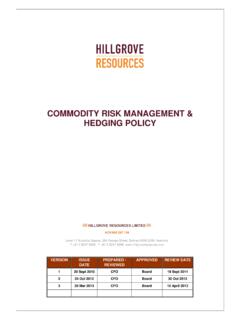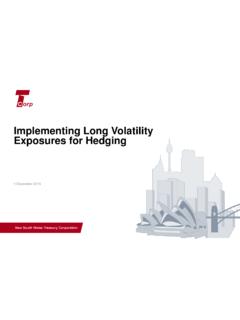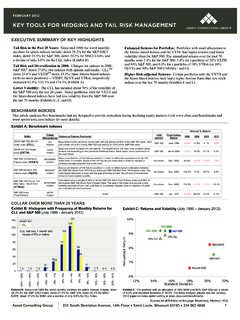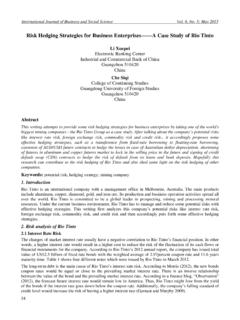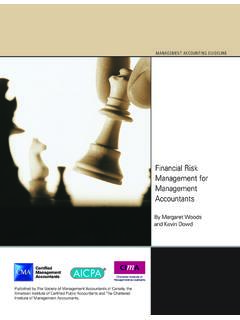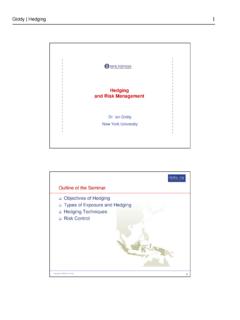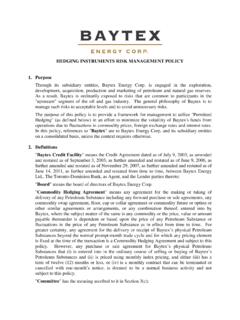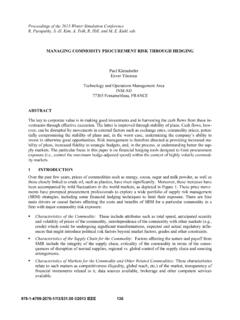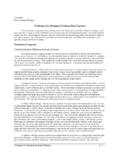Transcription of Electricity derivatives and risk management
1 Electricity derivatives and risk Denga,*, OrenbaSchool of Industrial and Systems Engineering, Georgia Institute of Technology, Atlanta, GA 30332-0205, USAbDepartment of Industrial Engineering and Operations Research, University of California, Berkeley, CA 94720, USAA bstractElectricity spot prices in the emerging power markets are volatile, a consequence of the unique physicalattributes of Electricity production and distribution. Uncontrolled exposure to market price risks can lead todevastating consequences for market participants in the restructured Electricity industry. Lessons learned from thefinancial markets suggest that financial derivatives , when well understood and properly utilized, are beneficial tothe sharing and controlling of undesired risks through properly structured hedging strategies.
2 We review differenttypes of Electricity financial instruments and the general methodology for utilizing and pricing such instruments. Inparticular, we highlight the roles of these Electricity derivatives in mitigating market risks and structuring hedgingstrategies for generators, load serving entities, and power marketers in various risk management , we conclude by pointing out the existing challenges in current Electricity markets for increasing thebreadth, liquidity and use of Electricity derivatives for achieving economic Elsevier Ltd. All rights IntroductionElectricity spot prices are volatile due to the unique physical attributes of Electricity such as non-storability, uncertain and inelastic demand and a steep supply function.
3 Uncontrolled exposure to marketprice risks could lead to devastating consequences. During the summer of 1998, wholesale power pricesin the Midwest of US surged to a stunning $7000 per MWh from the ormal price range of $30 $60 perMWh, causing the defaults of two power marketers in the east coast. In February 2004, persistent highprices in Texas during a 3-day ice storm led to the bankruptcy of a retail energy provider that wasexposed to spot market prices. And of course, the California Electricity crisis of 2000/2001 and itsdevastating economic consequences are largely attributed to the fact that the major utilities were notproperly hedged through long-term supply contracts. Such expensive lessons have raised the awarenessEnergy 31 (2006) 940 $ - see front matterq2005 Elsevier Ltd.
4 All rights *Corresponding author. Tel.:C1 404 894 6519; fax:C1 404 894 ( Deng).of market participants to the importance and necessity of risk management practices in competitiveelectricity of risk by a corporation should in principle be motivated by the goal of maximizing firm svalue. hedging achieves value enhancement by reducing the likelihood of financial distress and itsensuing costs, or by reducing the variance of taxable incomes and its associated present value of futuretax liabilities. Regulatory rules also play an important role in hedging practices. In California, forinstance, the regulators granted the incumbent investor-owned utilities (IOUs) a fixed time frame torecover their stranded generation costs through the Competition Transition Charge.
5 Fearing adversemarket conditions causing insufficient recovery of the stranded costs, one major utility company hiredinvestment bankers to structure and implement an extensive hedging strategy for its stranded-costrecovery. On the other hand, the reluctance of the regulators in California to immunize the IOUs againstex-post prudence review of long-term supply contracts discouraged the adoption of such contracts,resulting in over-reliance of the IOUs on the spot market for Electricity procurement. This excessiveexposure led to the near collapse of the California utility industry in 2001, with devastating economiclosses due to prolonged outages and substantial rate the competitive but volatile Electricity markets mature, generation companies, power marketersand load serving entities (LSEs) seek certainty in their costs and revenues through hedging practices andcontracting and active trading.
6 Such activities involve quantifying, monitoring and controlling tradingrisks in the wholesale and retail power markets, which in turn require appropriate risk management toolsand the supply side, managing risk associated with long-term investment in generation andtransmission requires methods and tools for planning under uncertainty and for asset valuation. Much ofthe demands for generation asset valuation methods were spurred by the mandatory divestiture ofgeneration assets already owned by major utility companies in various jurisdictions. For example, inCalifornia, most of the fossil-fuel plants held by the three IOUs, which account for about 60% of the totalinstalled capacity in California by 2000, have been or will be divested to other parties.
7 The need for assetvaluation also rises from analysis of investment in new generation capacity and from efforts byregulators in the US and abroad to develop incentives for investment in generation capacity to meetsupply adequacy and system reliability fundamental vision underlying the worldwide movement toward a competitive Electricity industryhas been that most of the efficiency gains from restructuring come from long-run investments ingenerating capacity. Under the state-ownership or required rate-of-return regulatory regime, utilitycompanies were allowed to earn a regulated rate of return above their cost of capital. Once regulatorsapproved the construction costs of a power generating plant, the costs would be passed onto consumersthrough regulated Electricity prices over the life of the investment, independent of the fluctuation inmarket value of the investment over time due to changing energy prices, improving technology, andevolving supply and demand conditions.
8 Most of the investment risks in generating capacity wereallocated to consumers rather than producers. Firms, therefore, had little incentives to avoid excessivecost of investment and they focused on improving and maintaining quality of service rather than ondeveloping and adopting new generation market reforms around the world have shifted much of the investment risk from consumersto producers. Under the ideal theoretical paradigm, shareholders bear all the investment risk andconsumers bear the price risk, with competitive entry pushing generation capacity toward desired long-term equilibrium. In such an ideal market environment, suppliers and consumers are free to choose Deng, Oren / Energy 31 (2006) 940 953941desired level of risk exposure, achieved through voluntary risk management practices.
9 Unfortunately,this idealized vision of a competitive Electricity market is not working as expected, primarily due to suchmarket imperfections as lack of demand response, abuse of locational market power, and politicalresistance to high prices reflecting scarcity rents and few exceptions such as Australia (where Electricity spot prices are allowed to rise to $10,000 perMWh), most restructured Electricity markets in the US and around the world have backed away from theidealized economic market models and instituted price caps and various capacity payment regulatory interventions allocate risks between consumers and producers by limiting pricevolatility for consumers and assuring investment cost recovery for generators.
10 From a risk managementperspective, these intervention schemes are mandatory backstop hedging that limits the exposures ofconsumers and producers. The proper design of such schemes requires the same pricing and assetvaluation tools as voluntary risk management practices in a competitive market. For instance, a price capof $1000/MWh can be viewed as a mandatory call option imposed on all produced Electricity with astrike price of $1000/MWh, with the option premium being the proper capacity payment for generatorsabiding by the organization of the rest of the paper is as follows. Section 2 describes the institutional features ofseveral types of commonly traded Electricity instruments. Section 3 highlights the essential elements inelectricity derivative pricing and introduces the pricing methodologies.

